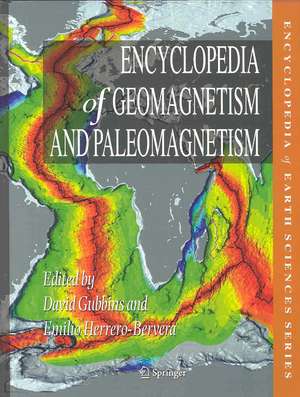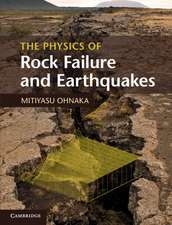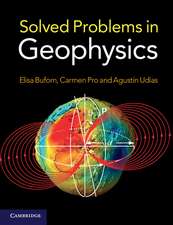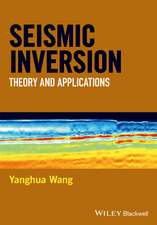Encyclopedia of Geomagnetism and Paleomagnetism: Encyclopedia of Earth Sciences Series
Editat de David Gubbins, Emilio Herrero-Berveraen Limba Engleză Hardback – 25 iun 2007
The magnetic record left in rocks is studied in Paleomagnetism. Both fields have applications, pure and applied: in navigation, in the search for minerals and hydrocarbons, in dating rock sequences, and in unraveling past geologic movements such as plate motions they have contributed to a better understanding of the Earth.
Consisting of more than 300 articles written by ca 200 leading experts, this authoritative reference encompasses the entire fields of Geomagnetism and Paleomagnetism in a single volume. It describes in fine detail at an assessable level the state of the current knowledge and provides an up-to-date synthesis of the most basic concepts. As such, it will be an indispensable working tool not only for geophysicists and geophysics students but also for geologists, physicists, atmospheric and environmental scientists, and engineers.
Din seria Encyclopedia of Earth Sciences Series
- 18%
 Preț: 3655.93 lei
Preț: 3655.93 lei - 18%
 Preț: 3123.97 lei
Preț: 3123.97 lei - 18%
 Preț: 2565.22 lei
Preț: 2565.22 lei - 18%
 Preț: 2828.03 lei
Preț: 2828.03 lei - 18%
 Preț: 3984.35 lei
Preț: 3984.35 lei - 18%
 Preț: 3380.49 lei
Preț: 3380.49 lei - 18%
 Preț: 3917.94 lei
Preț: 3917.94 lei - 18%
 Preț: 3354.74 lei
Preț: 3354.74 lei - 18%
 Preț: 3664.42 lei
Preț: 3664.42 lei - 18%
 Preț: 1901.16 lei
Preț: 1901.16 lei - 18%
 Preț: 3041.93 lei
Preț: 3041.93 lei - 18%
 Preț: 3055.49 lei
Preț: 3055.49 lei - 24%
 Preț: 2488.06 lei
Preț: 2488.06 lei - 24%
 Preț: 2672.29 lei
Preț: 2672.29 lei - 18%
 Preț: 1849.26 lei
Preț: 1849.26 lei - 24%
 Preț: 3329.20 lei
Preț: 3329.20 lei - 18%
 Preț: 2802.01 lei
Preț: 2802.01 lei - 24%
 Preț: 1685.65 lei
Preț: 1685.65 lei - 18%
 Preț: 3335.19 lei
Preț: 3335.19 lei - 24%
 Preț: 2953.18 lei
Preț: 2953.18 lei - 24%
 Preț: 1685.12 lei
Preț: 1685.12 lei - 24%
 Preț: 1689.65 lei
Preț: 1689.65 lei - 14%
 Preț: 2198.26 lei
Preț: 2198.26 lei - 9%
 Preț: 1677.82 lei
Preț: 1677.82 lei - 14%
 Preț: 1632.58 lei
Preț: 1632.58 lei - 14%
 Preț: 1849.21 lei
Preț: 1849.21 lei - 14%
 Preț: 2571.39 lei
Preț: 2571.39 lei - 14%
 Preț: 1945.49 lei
Preț: 1945.49 lei - 14%
 Preț: 1945.49 lei
Preț: 1945.49 lei - 14%
 Preț: 1945.49 lei
Preț: 1945.49 lei - 14%
 Preț: 1945.49 lei
Preț: 1945.49 lei - 9%
 Preț: 2703.12 lei
Preț: 2703.12 lei - 14%
 Preț: 1945.49 lei
Preț: 1945.49 lei - 14%
 Preț: 1945.49 lei
Preț: 1945.49 lei - 14%
 Preț: 2130.86 lei
Preț: 2130.86 lei
Preț: 3381.42 lei
Preț vechi: 4123.69 lei
-18% Nou
Puncte Express: 5072
Preț estimativ în valută:
647.03€ • 674.23$ • 535.74£
647.03€ • 674.23$ • 535.74£
Carte disponibilă
Livrare economică 13-27 martie
Preluare comenzi: 021 569.72.76
Specificații
ISBN-13: 9781402039928
ISBN-10: 1402039921
Pagini: 1054
Ilustrații: XXVI, 1054 p. 718 illus., 50 illus. in color.
Dimensiuni: 210 x 280 x 47 mm
Greutate: 3.16 kg
Ediția:2007
Editura: SPRINGER NETHERLANDS
Colecția Springer
Seria Encyclopedia of Earth Sciences Series
Locul publicării:Dordrecht, Netherlands
ISBN-10: 1402039921
Pagini: 1054
Ilustrații: XXVI, 1054 p. 718 illus., 50 illus. in color.
Dimensiuni: 210 x 280 x 47 mm
Greutate: 3.16 kg
Ediția:2007
Editura: SPRINGER NETHERLANDS
Colecția Springer
Seria Encyclopedia of Earth Sciences Series
Locul publicării:Dordrecht, Netherlands
Public țintă
ResearchCuprins
Aeromagnetic surveying.- Agricola, Georgius (1494–1555).- Alfvén waves.- Alfvén, Hannes Olof Gösta (1908–1995).- Alfvén's theorem and the frozen flux approximation.- Anelastic and Boussinesq approximations.- Anisotropy, electrical.- Anti-dynamo and bounding theorems.- Archaeology, magnetic methods.- Archaeomagnetism.- Auroral oval.- Baked contact test.- Bangui anomaly.- Barlow, Peter (1776–1862).- Bartels, Julius (1899–1964).- Bauer, Louis Agricola (1865–1932).- Bemmelen, Willem van (1868–1941).- Benton, Edward R. (1934–1992).- Bingham statistics.- Biomagnetism.- Blackett, Patrick Maynard Stuart, Baron of Chelsea (1897–1974).- Bullard, Edward Crisp (1907–1980).- Carnegie Institution of Washington, Department of Terrestrial Magnetism.- Carnegie, research vessel.- CHAMP.- Chapman, Sydney (1888–1970).- Coast effect of induced currents.- Compass.- Conductivity geothermometer.- Conductivity, ocean floor measurements .- Convection, chemical.- Convection, non-magnetic rotating.- Core composition.- Core convection.- Core density.- Core motions.- Core origin.- Core properties, physical.- Core properties, theoretical determination.- Core temperature.- Core turbulence.- Core viscosity.- Core, adiabatic gradient.- Core, boundary layers.- Core, electrical conductivity.- Core, magnetic instabilities.- Core, thermal conduction.- Core-based inversions for the main geomagnetic field.- Core-mantle boundary topography, implications for dynamics.- Core-mantle boundary topography, seismology.- Core-mantle boundary, heat flow across.- Core-mantle coupling, electromagnetic.- Core-mantle coupling, thermal.- Core-mantle coupling, topographic .- Cowling, Thomas George (1906–1990).- Cowling's Theorem.- Cox, Allan V. (1926–1987).- Crustal magnetic field.- D'' and F Layers of the Earth.- D'' as a boundary layer.- D'', anisotropy.- D'', composition.- D'', seismic properties.- Della Porta, Giambattista (1535–1615).- Demagnetization.- Depth to Curie temperature.- Dipole moment variation.- Dynamo waves.- Dynamo, Backus .- Dynamo, Braginsky .- Dynamo, Bullard-Gellman.- Dynamo, disk.- Dynamo, Gailitis.- Dynamo, Herzenberg.- Dynamo, Lowes-Wilkinson.- Dynamo, Model-Z.- Dynamo, Ponomarenko .- Dynamo, solar.- Dynamos, experimental.- Dynamos, fast.- Dynamos, kinematic .- Dynamos, mean field.- Dynamos, periodic .- Dynamos, planetary and satellite.- Earth structure, major divisions.- Elsasser, Walter M. (?–1991).- EM modeling, forward.- EM modeling, inverse.- EM, industrial uses.- EM, lake bottom measurements.- EM, land uses.- EM, regional studies.- EM, tectonic interpretations.- Environmental magnetism.- Environmental magnetism, paleomagnetic applications.- Equilibration of magnetic field, weak and strong field dynamos.- Euler deconvolution.- First-order reversal curve (FORC) diagrams.- Fisher statistics.- Fleming, John Adam (1877–1855).- Fluid dynamics experiments.- Galvanic distortion.- Gauss' determination of absolute intensity.- Gauss, Carl Friedrich (1777–1855).- Gellibrand, Henry (1597–1636).- Geocentric axial dipole hypothesis.- Geodynamo.- Geodynamo, dimensional analysis and timescales.- Geodynamo, energy sources.- Geodynamo, numerical simulations .- Geodynamo, symmetry properties.- Geomagnetic deep sounding.- Geomagnetic dipole field.- Geomagnetic excursion.- Geomagnetic field, asymmetries.- Geomagnetic hazards.- Geomagnetic jerks.- Geomagnetic polarity reversals.- Geomagnetic polarity reversals, observations.- Geomagnetic polarity timescales.- Geomagnetic pulsations.- Geomagnetic reversal sequence, statistical structure.- Geomagnetic reversals, archives.- Geomagnetic secular variation.- Geomagnetic spectrum, spatial.- Geomagnetic spectrum, temporal.- Geomagnetism, history of.- Gilbert William (1544–1603).- Gravitational torque.- Gravity-inertio waves and inertial oscillations.- Grüneisen's parameter for iron and Earth's core.- Halley, Edmond (1656–1742).- Hansteen, Christopher (1784–1873).- Harmonics, spherical.- Harmonics, spherical cap.- Hartmann, Georg (1489–1564).- Helioseismology.- Higgins-Kennedy paradox.- Humboldt, Alexander von (1759–1859).- Humboldt, Alexander von and magnetic storms.- IAGA, International Association of Geomagnetism and Aeronomy.- Ideal solution theory.- IGRF, International Geomagnetic Reference Field.- Induction arrows.- Induction from satellite data.- Inhomogeneous boundary conditions and the dynamo.- Inner core anisotropy.- Inner core composition.- Inner core oscillation.- Inner core rotation.- Inner core rotational dynamics.- Inner core seismic velocities.- Inner core tangent cylinder.- Inner core, PKJKP.- Instrumentation, history of .- Interiors of planets and satellites.- Internal external field separation.- Ionosphere.- Iron sulphides.- Jesuits, role in geomagnetism.- Kircher, Athanasius (1602–1680).- Langel, Robert A. (1937–2000).- Laplace's equation, uniqueness of solutions.- Larmor, Joseph (1857–1942).- Lehmann, Inge (1888–1993).- Length of day variations, decadal.- Length of day variations, long term.- Lloyd, Humphrey (1808–1881).- Magnetic anisotropy, sedimentary rocks and strain alteration.- Magnetic anomalies for geology and resources.- Magnetic anomalies, long wavelength.- Magnetic anomalies, marine.- Magnetic anomalies, modeling.- Magnetic domain.- Magnetic field of Mars.- Magnetic field of Sun.- Magnetic indices.- Magnetic mineralogy, changes due to heating.- Magnetic properties, low-temperature.- Magnetic proxy parameters.- Magnetic remanence, anisotropy.- Magnetic shielding.- Magnetic surveys, marine.- Magnetic susceptibility, anisotropy.- Magnetic susceptibility, anisotropy, effects of heating.- Magnetic susceptibility, anisotropy, rock fabric.- Magnetic susceptibility, low-field.- Magnetization, anhysteretic remanent (ARM).- Magnetization, chemical remanent (CRM).- Magnetization, depositional remanent (DRM).- Magnetization, isothermal remanent (IRM).- Magnetization, natural remanent (NRM).- Magnetization, oceanic crust.- Magnetization, piezo-remanent.- Magnetization, remanent, application.- Magnetization, remanent, fold test.- Magnetization, thermoremanent (TRM).- Magnetization, thermoremanent, in minerals.- Magnetization, viscous remanent (VRM).- Magnetoconvection.- Magnetohydrodynamic waves.- Magnetohydrodynamics.- Magnetometers, laboratory.- Magnetosphere of the Earth.- Magnetostratigraphy.- Magnetotellurics.- Magsat.- Main field maps.- Main field modelling.- Main field, ellipticity correction.- Mantle, electrical conductivity, mineralogy.- Mantle, thermal conductivity.- Marine controlled source EM.- Matuyama, Motonori (1884–1958).- Melting temperature of iron in the core, experimental.- Melting temperature of iron in the core, theory.- Microwave palaeomagnetic technique.- Nagata, Takesi (1913–1991).- Natural sources for EM induction studies.- Neél, Louis (1904–2000).- Non-dipole field.- Non-dynamo theories.- Norman, Robert (1560–1585).- Observatories, overview.- Observatories instrumentation.- Observatories automation.- Observatories, intermagnet.- Observatories programme in Australia.- Observatories programme in the British Isles.- Observatories programme in France.- Observatories programme in USA.- Observatories in Antarctica.- Observatories in Benelux countries.- Observatories in Canada.- Observatories in China.- Observatories in East and Central Europe.- Observatories in Germany.- Observatories in India.- Observatories in Italy.- Observatories in Japan and Asia.- Observatories in Latin America.- Observatories in New Zealand and the South Pacific.- Observatories in Nordic countries.- Observatories in Russia.- Observatories in southern Africa.- Observatories in Spain.- Ocean, electromagnetic effects.- Oldham, Richard Dixon (1858–1936).- Ørsted, Hans Christian (1777–1851).- Oscillations, torsional.- Paleointensity, absolute, determination.- Paleointensity, absolute, techniques.- Paleointensity, relative, in sediments.- Paleomagnetic field collection methods.- Paleomagnetic secular variation.- Paleomagnetism.- Paleomagnetism, deep-sea sediments.- Paleomagnetism, extraterrestrial.- Paleomagnetism, orogenic belts.- Parkinson, Wilfred Dudley (1919–2001).- Peregrinus, Petrus (c. 1220–?).- Periodic external fields.- Plate tectonics, China.- POGO (OGO-2, -4 and -6 spacecraft).- Polarity transition, paleomagnetic record.- Polarity transitions.- Pole, paleomagnetic.- Potential vorticity and potential magnetic field theorems.- Precession and core dynamics.- Price, Albert Thomas (1903–1978).- Principal component analysis in paleomagnetism.- Project MAGNET.- Proudman-Taylor theorem.- Radioactive isotopes, their decay in mantle and core.- Reduction to pole.- Repeat stations.- Reversals, theory.- Rikitake, Tsuneji (1921–?).- Ring current.- Robust electromagnetic transfer functions estimates.- Rock magnetism.- Rock magnetism, hysteresis measurements.- Rock magnetometer, superconducting.- Runcorn, S. Keith (1922–1995).- Runcorn's theorem.- Sabine, Edward (1788–1883).- Seamount magnetism.- Secular variation model.-SEDI .- Seismic phases.- Seismo-electromagnetic effects.- Shaw and microwave methods, absolute paleointensity determination.- Shock wave experiments.- Spinner magnetometer.- Statistical methods for paleovector analysis.- Storms and substorms, magnetic.- Stress demagnetization.- Superchrons, changes in reversal frequency.- Susceptibility.- Susceptibility, measurements of solids.- Susceptibility, parameters, anisotropy.- Taylor's condition.- Thellier, Émile (1904–1987).- Thermal wind.- Time-averaged paleomagnetic field.- Time-dependent models of the geomagnetic field.- Transfer functions.- Transient EM induction.- True polar wander.- ULVZ, ultra-low velocity zone.- Units.- Upward and downward continuation.- Variable field translation balance.- Verhoogen, John (1912–1993).- Vine-Matthews-Morley hypothesis.- Volcano-electromagnetic effects.- Voyages making geomagnetic measurements.- Watkins, Norman David (1934–1977).- Westward drift.
Recenzii
From the reviews:
"This new encyclopedia focuses mainly on the magnetic field of internal origin; however, some related articles on external sources are included. The editor’s goal is to cover the subject in fine detail at a level understandable to anyone with a general scientific education. The work includes 318 alphabetically arranged entries written by 226 specialists in the field. Each entry has a short bibliography and cross-references. … Summing Up: Recommended. Upper-level undergraduates through professionals/practitioners." (L. Joseph, CHOICE, Vol. 45 (6), 2008)
"This new Encyclopedia … present universal knowledge in the fields of Geomagnetism and Paleomagnetism in the broadest sense and in a single volume. … Written at a level accessible to anyone with a scientific education, this authoritative and speedy reference is … to all whose activities or studies are concerned with both fields. It is therefore a valuable working tool not only for geophysicists and geophysics students but also for physicists, geologists, geographers, atmospheric and environmental scientists and engineers." (Jozef Hus and Jean-Claude Jodogne, Physicalia Magazine, Vol. 30 (1), 2008)
"The Encyclopedia of Geomagnetism and Paleomagnetism is part of the Encyclopedia of Earth Sciences Series. … Numerous diagrams, pictures, tables, formulas, and mathematical equations provide clarity to the discussions. A detailed 44-page subject index and a series of color plates, mostly magnetic field maps, appear at the end of the volume. … this encyclopedia will be of particular interest to students and professionals in the earth sciences. This work is recommended for college, university, and larger public libraries." (Ignacio J. Ferrer-Vinent, ARBAonline, Vol. 39, 2008)
"This is major work whose aim is to provide a comprehensive review of all aspects of geomagnetism and palaeomagnetism as the subjects are currently understood. … the articles are well illustrated, well written and comprehensible to the reader. … I do believe that it is an indispensible library tool for graduates, academics and professionals alike involved in the application or study of geomagnetism and palaeomagnetism. For those already involved in a particular aspect of this broad discipline it provides a useful pathway to allied subjects." (Graeme Taylor, Geological Magazine, Vol. 145 (3), 2008)
"This volume claims to be the first single encyclopaedia to cover the combined fields of geomagnetism and paleomagnetism. … aims to provide a comprehensive and authoritative coverage of these complex and ever expanding subjects. … A very useful list of cross-references is provided at the end of each article, which makes it much easier to link together areas that are less familiar. … In the main this book is for those specialising in geophysics … . vital for academic libraries with geology and geophysics departments." (Helen Ashton, Reference Reviews, Vol. 22 (3), 2008)
"This new encyclopedia focuses mainly on the magnetic field of internal origin; however, some related articles on external sources are included. The editor’s goal is to cover the subject in fine detail at a level understandable to anyone with a general scientific education. The work includes 318 alphabetically arranged entries written by 226 specialists in the field. Each entry has a short bibliography and cross-references. … Summing Up: Recommended. Upper-level undergraduates through professionals/practitioners." (L. Joseph, CHOICE, Vol. 45 (6), 2008)
"This new Encyclopedia … present universal knowledge in the fields of Geomagnetism and Paleomagnetism in the broadest sense and in a single volume. … Written at a level accessible to anyone with a scientific education, this authoritative and speedy reference is … to all whose activities or studies are concerned with both fields. It is therefore a valuable working tool not only for geophysicists and geophysics students but also for physicists, geologists, geographers, atmospheric and environmental scientists and engineers." (Jozef Hus and Jean-Claude Jodogne, Physicalia Magazine, Vol. 30 (1), 2008)
"The Encyclopedia of Geomagnetism and Paleomagnetism is part of the Encyclopedia of Earth Sciences Series. … Numerous diagrams, pictures, tables, formulas, and mathematical equations provide clarity to the discussions. A detailed 44-page subject index and a series of color plates, mostly magnetic field maps, appear at the end of the volume. … this encyclopedia will be of particular interest to students and professionals in the earth sciences. This work is recommended for college, university, and larger public libraries." (Ignacio J. Ferrer-Vinent, ARBAonline, Vol. 39, 2008)
"This is major work whose aim is to provide a comprehensive review of all aspects of geomagnetism and palaeomagnetism as the subjects are currently understood. … the articles are well illustrated, well written and comprehensible to the reader. … I do believe that it is an indispensible library tool for graduates, academics and professionals alike involved in the application or study of geomagnetism and palaeomagnetism. For those already involved in a particular aspect of this broad discipline it provides a useful pathway to allied subjects." (Graeme Taylor, Geological Magazine, Vol. 145 (3), 2008)
"This volume claims to be the first single encyclopaedia to cover the combined fields of geomagnetism and paleomagnetism. … aims to provide a comprehensive and authoritative coverage of these complex and ever expanding subjects. … A very useful list of cross-references is provided at the end of each article, which makes it much easier to link together areas that are less familiar. … In the main this book is for those specialising in geophysics … . vital for academic libraries with geology and geophysics departments." (Helen Ashton, Reference Reviews, Vol. 22 (3), 2008)
Notă biografică
David Gubbins is Research Professor of Earth Sciences in the School of Earth & Environment, University of Leeds, UK. He did his PhD on geomagnetic dynamos in Cambridge, supervised by Sir Edward Bullard (qv.) and has worked in the USA and in Cambridge before moving to Leeds in 1989. His work has included dynamo theory and its connection with the Earth's thermal history, modelling the Earth's magnetic field from historical measurements, and recently the interpretation of paleomagnetic data. He is a Fellow of the Royal Society and has been awarded the Gold Medal of the Royal Astronomical Society and the John Adam Fleming (qv.) Medal of the American Geophysical Union for original research and leadership in geomagnetism.
Emilio Herrero-Bervera is Research Professor of Geophysics at the School of Ocean Earth Science and Technology (SOEST) within the Hawaii Institute of Geophysics and Planetology (HIGP) of the University of Hawaii at Manoa, where he is the head of the Paleomagnetics and Petrofabrics Laboratory. During his career he has published over 90 papers in professional journals including Nature, JGR, EPSL, JVGR. He has worked in such diverse fields as volcanology, sedimentology, plate tectonics and has done field work on 5 continents
Emilio Herrero-Bervera is Research Professor of Geophysics at the School of Ocean Earth Science and Technology (SOEST) within the Hawaii Institute of Geophysics and Planetology (HIGP) of the University of Hawaii at Manoa, where he is the head of the Paleomagnetics and Petrofabrics Laboratory. During his career he has published over 90 papers in professional journals including Nature, JGR, EPSL, JVGR. He has worked in such diverse fields as volcanology, sedimentology, plate tectonics and has done field work on 5 continents
Textul de pe ultima copertă
Understanding the process underlying the origin of Earth magnetic field is one of the greatest challenges left to classical Physics. Geomagnetism, being the oldest Earth science, studies the Earth’s magnetic field in its broadest sense.
The magnetic record left in rocks is studied in Paleomagnetism. Both fields have applications, pure and applied: in navigation, in the search for minerals and hydrocarbons, in dating rock sequences, and in unraveling past geologic movements such as plate motions they have contributed to a better understanding of the Earth.
Consisting of more than 300 articles written by ca 200 leading experts, this authoritative reference encompasses the entire fields of Geomagnetism and Paleomagnetism in a single volume. It describes in fine detail at an assessable level the state of the current knowledge and provides an up-to-date synthesis of the most basic concepts. As such, it will be an indispensable working tool not only for geophysicists and geophysics students but also for geologists, physicists, atmospheric and environmental scientists, and engineers.
The Editors
David Gubbins is Research Professor of Earth Sciences in the School of Earth & Environment, University of Leeds, UK. He did his PhD on geomagnetic dynamos in Cambridge, supervised by Sir Edward Bullard (q.v.) and has worked in the USA and in Cambridge before moving to Leeds in 1989. His work has included dynamo theory and its connection with the Earth's thermal history, modeling the Earth's magnetic field from historical measurements, and recently the interpretation of paleomagnetic data. He is a Fellow of the Royal Society and has been awarded the Gold Medal of the Royal Astronomical Society and the John Adam Fleming (q.v.) Medal of the American Geophysical Union for original research and leadership in geomagnetism.
Emilio Herrero-Bervera is Research Professor of Geophysics at the School of Ocean Earth Science and Technology (SOEST) within the Hawaii Institute of Geophysics and Planetology (HIGP) of the University of Hawaii at Manoa, where he is the head of the Paleomagnetics and Petrofabrics Laboratory. During his career he has published over 90 papers in professional journals including Nature, JGR, EPSL, and JVGR. He has worked in such diverse fields as volcanology, sedimentology, and plate tectonics and has done fieldwork on 5 continents.
The magnetic record left in rocks is studied in Paleomagnetism. Both fields have applications, pure and applied: in navigation, in the search for minerals and hydrocarbons, in dating rock sequences, and in unraveling past geologic movements such as plate motions they have contributed to a better understanding of the Earth.
Consisting of more than 300 articles written by ca 200 leading experts, this authoritative reference encompasses the entire fields of Geomagnetism and Paleomagnetism in a single volume. It describes in fine detail at an assessable level the state of the current knowledge and provides an up-to-date synthesis of the most basic concepts. As such, it will be an indispensable working tool not only for geophysicists and geophysics students but also for geologists, physicists, atmospheric and environmental scientists, and engineers.
The Editors
David Gubbins is Research Professor of Earth Sciences in the School of Earth & Environment, University of Leeds, UK. He did his PhD on geomagnetic dynamos in Cambridge, supervised by Sir Edward Bullard (q.v.) and has worked in the USA and in Cambridge before moving to Leeds in 1989. His work has included dynamo theory and its connection with the Earth's thermal history, modeling the Earth's magnetic field from historical measurements, and recently the interpretation of paleomagnetic data. He is a Fellow of the Royal Society and has been awarded the Gold Medal of the Royal Astronomical Society and the John Adam Fleming (q.v.) Medal of the American Geophysical Union for original research and leadership in geomagnetism.
Emilio Herrero-Bervera is Research Professor of Geophysics at the School of Ocean Earth Science and Technology (SOEST) within the Hawaii Institute of Geophysics and Planetology (HIGP) of the University of Hawaii at Manoa, where he is the head of the Paleomagnetics and Petrofabrics Laboratory. During his career he has published over 90 papers in professional journals including Nature, JGR, EPSL, and JVGR. He has worked in such diverse fields as volcanology, sedimentology, and plate tectonics and has done fieldwork on 5 continents.
Caracteristici
More than 300 entries by some 200 of the foremost experts from all over the world Up-to-date and comprehensive. The first single encyclopedia to cover the combined fields of Geomagnetism and Paleomagnetism Individual entries range in length from 500 to 12000 words Draws together a unique overview of world wide geomagnetic observatories Includes numerous illustrations and a 16 page full color section Excellent indices, cross-references and extensive bibliographies Includes supplementary material: sn.pub/extras










